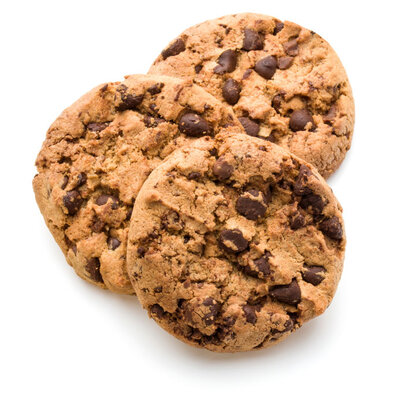Origin
Chocolate chip cookies were created in the 1930s by the Massachusetts cook Ruth Wakerfield, and were originally called Toll House Chocolate Crunch Cookie.
In 1939, Nestlé introduced to the market chocolate chips or morsels and started printing Wakerfield’s recipe on the package. In 1953, the chocolate chip cookie mix by Pillsbury was introduced to the US market. Today, chocolate chip cookies are the most popular cookies in the US.2
Ingredients
Commonly used ingredients for the production of chocolate chip cookies:3,2
| Ingredient | Type | Usage level (Baker’s percentage) | Function |
|---|---|---|---|
| Flour | Low protein flour (All- purpose flour or cake flour) | 100% |
|
| Fat | Butter, margarine, or shortening | 55% |
|
| Sugar | Granulated white sugar, brown sugar or a combination of both | 51% |
|
| Chocolate Chips | Dark or milk chocolate | 30% |
|
| Water | – | 19% |
|
| Eggs | Whole egg, egg powder | 2% |
|
| Leavening Agents | Baking powder, baking soda or ammonium bicarbonate. | 0.96% |
|
| Salt | Granulated | 0.96% |
|
| Vanilla | Extract or fresh | 0.96% |
|
Nutrition
Typical nutritional value of commercially available chocolate chip cookies per 100 g:4
| Carbohydrate | 72.00 |
| Water | 12.00 |
| Fat | 12.00 |
| Protein | 4.00 |
The high sugar and saturated fat levels in chocolate chip cookies make them highly caloric (350 – 370 kcal per 100 g).4
Commercial production
Chocolate chip cookies are commercially produced through the following process:3
- Scaling and weighing ingredients separately.
- First stage mixing: fat, sugars, water, salt, eggs, vanilla and leavening agent are mixed in a horizontal or vertical mixer.
- Second stage mixing: flour is added and mixing continues till homogeneous.
- Chocolate chip addition.
- Forming: dough is fed to the hopper of a wire cut machine, and the cut dough pieces are placed on a greased baking tray.
- Baking: cookie dough is baked at 180 – 220 oC (356 – 428 oF) for 7 min.
- Cooling: cookies are cooled down for 5 min.
- Packaging and storage.
Application
Considerations for a variety of chocolate chip cookies:1
| TYPE | |||
|---|---|---|---|
| Condition | Chewy | Crunchy | Crispy |
| Temperature | 163 °C (325 -350°F) or higher | 163 °C (325 -350°F) or higher | < 163 °C (325°F) |
| Time | 14 min | 23 min | 30 min |
| Sugar | Brown sugar | White sugar | White sugar |
| Fat | Vegetable shortening | Vegetable shortening | Butter |
| Cooling of the dough | Yes | Yes | No |
| Flour | All-purpose or bread flour | All-purpose | All-purpose |
Considerations for various cookie types:3
- Chewy: low moisture, sugar and fat prevent excessive spreading while short baking time provides the desired softness.
- Crunchy: low moisture, sugar, fat, and long baking time generates a light and crunchy cookie.
- Crispy: using butter aids in spreading and allows long time baking to form a crispy exterior.
Regulations
Chocolate chip cookies have a commercial item description established by the USDA. All ingredients used in its production are considered GRAS when following Good Manufacturing Practices.5
No specific regulations exist in the EU for chocolate chip cookies. All core ingredients are considered safe when following Good Manufacturing Practices.
References
- Hamel, P.J. Cookie Chemistry: A simple path to chocolate chip cookies with the texture you crave. King Arthur Baking Company, 2016. Available at https://www.kingarthurbaking.com/blog/2016/03/14/cookie-chemistry-2 . Accessed 05 April 2021.
- Smith, A, and Kraig,B. eds. The Oxford encyclopedia of food and drink in America. Vol. 1. Oxford University Press, 2013, pp. 941 – 943.
- Davidson, I. Biscuit Baking Technology: Processing and Engineering Manual. Netherlands, Elsevier Science, 2016, pp. 27 – 31.
- U.S. Department of Agriculture, Agricultural Research Service. FoodData Central, 15 February 2018. https://fdc.nal.usda.gov/fdc-app.html#/food-details/1636410/nutrients. Accessed 05 April 2021.
- U.S. Department of Agriculture, Agricultural Research Service. Commercial Item Description: Cookies. https://www.ams.usda.gov/sites/default/files/media/CID%20Cookies.pdf. Accessed 05 April 2021.

